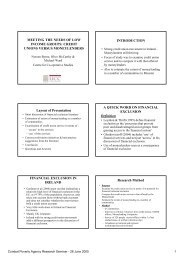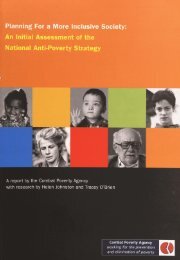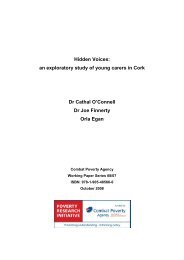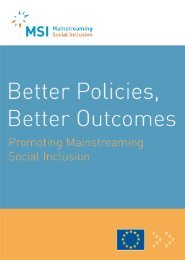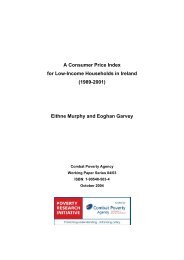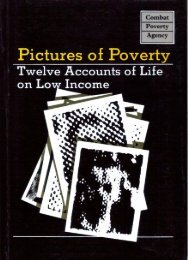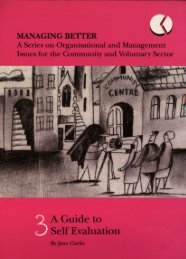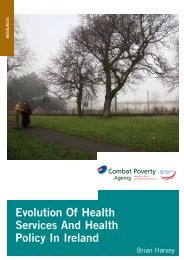The Distribution of Income in Ireland (2000) - Combat Poverty Agency
The Distribution of Income in Ireland (2000) - Combat Poverty Agency
The Distribution of Income in Ireland (2000) - Combat Poverty Agency
- No tags were found...
Create successful ePaper yourself
Turn your PDF publications into a flip-book with our unique Google optimized e-Paper software.
86<strong>The</strong> <strong>Distribution</strong> <strong>of</strong> <strong>Income</strong> <strong>in</strong> <strong>Ireland</strong>employment, on the other hand, with a greater <strong>in</strong>crease <strong>in</strong> employmentfor women with low-earn<strong>in</strong>g rather than high-earn<strong>in</strong>ghusbands, might <strong>in</strong> itself be expected to reduce household <strong>in</strong>come<strong>in</strong>equality.It is <strong>in</strong>terest<strong>in</strong>g to contrast the Irish experience with whathas been happen<strong>in</strong>g <strong>in</strong> the US, where Juhn and Murphy (1997)exam<strong>in</strong>ed changes <strong>in</strong> female earn<strong>in</strong>gs and employment between1969 and 1989. <strong>The</strong>ir analysis shows that the trend <strong>in</strong> femalewage behaviour <strong>in</strong> the US is similar to <strong>Ireland</strong>, with thelargest ga<strong>in</strong>s be<strong>in</strong>g experienced by women married to highearn<strong>in</strong>g husbands. However, the employment behaviour overthe period is the opposite <strong>of</strong> what we have just seen for <strong>Ireland</strong>:the highest employment rates were <strong>in</strong>itially found amongwomen married to low <strong>in</strong>come men, but over time the largest<strong>in</strong>creases <strong>in</strong> employment have been among women married tohigh earn<strong>in</strong>g husbands. Thus, <strong>in</strong> the US both the wage changeeffects and the participation effects for females operated <strong>in</strong>such a way as to result <strong>in</strong> an <strong>in</strong>crease <strong>in</strong> household <strong>in</strong>come <strong>in</strong>equality.As we have shown for <strong>Ireland</strong> these forces operated <strong>in</strong>opposite directions between 1987 and 1994, and we must turnto a more detailed analysis <strong>in</strong> order to determ<strong>in</strong>e which <strong>of</strong> thetwo had the greater bear<strong>in</strong>g on <strong>in</strong>equality.Total household <strong>in</strong>come can be disaggregated <strong>in</strong>to its components<strong>in</strong> order to determ<strong>in</strong>e their <strong>in</strong>dividual impacts on <strong>in</strong>equality,allow<strong>in</strong>g us to identify the effect <strong>of</strong> wives' earn<strong>in</strong>gs andemployment on <strong>in</strong>equality and how it has been chang<strong>in</strong>g. <strong>The</strong>coefficient <strong>of</strong> variation is a summary <strong>in</strong>equality measure whichis particularly suited to this purpose, and we have used it to lookat ttie period from 1987 to 1994: the details <strong>of</strong> the methodologyT J T T T Sh ° Wn * Appendbc L »•resul * *WSt that,despite the fact that the correlation <strong>in</strong> spouses' earn<strong>in</strong>gs has <strong>in</strong>-T ^StantiaUy ° Ver •* period ' *» evolution <strong>of</strong> wives'fn^ 5 f ? equalis<strong>in</strong>g effect on the distribution <strong>of</strong> householddb«Z * ° Ver "* Peri ° d - *• leased correlationbetween the earn<strong>in</strong>gs <strong>of</strong> spouses would <strong>in</strong> itself have had a disequahs<strong>in</strong>geffect. However, its impact was outweighed by the retZl2*^ f ° n * eaJnmgS aCTOSS * "^ed women (as~LnTtr m P ° yed **»»*>> «* fa y * reduction <strong>in</strong> the correlationbetween wives' earn<strong>in</strong>gs and non-labour <strong>in</strong>come ThisFemale Labour Force Participation and Inequality87br<strong>in</strong>gs out the complexity <strong>of</strong> the relationships between <strong>in</strong>dividualand household <strong>in</strong>comes, and the need to carefully disaggregatethe different sources <strong>of</strong> <strong>in</strong>come accru<strong>in</strong>g to household membersand the ways <strong>in</strong> which they relate to each other.7.4 CONCLUSIONBetween 1987 and 1994 wage <strong>in</strong>equality <strong>in</strong> <strong>Ireland</strong> <strong>in</strong>creasedsubstantially yet household <strong>in</strong>come <strong>in</strong>equality, as reflected <strong>in</strong>the ESRI surveys carried out <strong>in</strong> those years, was stable or actuallyfell marg<strong>in</strong>ally. In this chapter we have exam<strong>in</strong>ed one possibleexplanation for this, namely the <strong>in</strong>creased contribution <strong>of</strong>female wages to total household <strong>in</strong>come. We have documentedthe changes <strong>in</strong> wives' employment rates and earn<strong>in</strong>gs over thisperiod, pay<strong>in</strong>g particular attention to how these varied with theeconomic status <strong>of</strong> the husband.We saw that while <strong>in</strong>creases <strong>in</strong> female employment rateswere greatest among wives married to low earn<strong>in</strong>g husbands,these women have experienced only modest wage ga<strong>in</strong>s whencompared to the wives <strong>of</strong> husbands with earn<strong>in</strong>gs above theaverage. <strong>The</strong>se changes have resulted <strong>in</strong> a reduction <strong>in</strong> the dispersion<strong>of</strong> earn<strong>in</strong>gs among all wives (the participation effect)but an <strong>in</strong>crease <strong>in</strong> dispersion among wives at work and an <strong>in</strong>crease<strong>in</strong> the correlation between spouses' earn<strong>in</strong>gs (bothwage effects).We then used a decomposition <strong>of</strong> the coefficient <strong>of</strong> variation,a summary measure <strong>of</strong> <strong>in</strong>equality, to exam<strong>in</strong>e the contribution<strong>of</strong> wives' earn<strong>in</strong>gs to changes <strong>in</strong> household <strong>in</strong>come <strong>in</strong>equalityover the period. <strong>The</strong> results suggest that the effect <strong>of</strong> the highercorrelation <strong>in</strong> spouses' earn<strong>in</strong>gs (which would <strong>in</strong> itself work to<strong>in</strong>crease <strong>in</strong>equality) was dom<strong>in</strong>ated by the other trends associatedwith wives' earn<strong>in</strong>gs. Overall, changes <strong>in</strong> wives' earn<strong>in</strong>gswould have had an equalis<strong>in</strong>g rather than disequalis<strong>in</strong>g impacton household <strong>in</strong>comes over the period.Although we have shown that trends <strong>in</strong> female participationrates have reduced <strong>in</strong>come <strong>in</strong>equality over the 1987-94 period,one must be careful <strong>in</strong> extrapolat<strong>in</strong>g these f<strong>in</strong>d<strong>in</strong>gs from thatpo<strong>in</strong>t on. Despite the rapid <strong>in</strong>creases <strong>in</strong> female participation,female earn<strong>in</strong>gs still accounted for only 15 per cent <strong>of</strong> total




